Damage in Rubble Mound Breakwaters. Part II: Review of the Definition, Parameterization, and Measurement of Damage
Abstract
1. Introduction
2. Review of Damage Definition, Damage Parameterization, and Damage Measurement
2.1. Damage Definition
- Initiation of damage: a certain number of armor units are displaced a distance equal to or larger than a nominal diameter (Dn50) from their original position. Holes larger than the average porous size are clearly appreciated, but the functionality of the structure is not compromised.
- Iribarren’s damage: the holes are big enough to expose the lower layer of the armor layer, which units start to be susceptible of being extracted. An incipient S-profile is developed.
- Initiation of destruction: it is similar to the concept of “initiation of damage” but applied to the lower layer of the armor layer. A small number of units (two or three) in the lower layer are pulled out and the underlayer starts to be exposed to wave action.
- Destruction: the underlayer is exposed to wave action and their units are easily removed. The mound is likely to eventually cease to give the designed level of service.
- Initial damage: few units are displaced, corresponding to the no damage level used in the Shore Protection Manual [17], referred as SPM in the present document.
- Intermediate damage: units are displaced but without causing exposure of the under layer or filter layer to direct wave attack.
- Failure: the under layer or filter layer is exposed to wave attack.
2.2. Damage Parameterization
- The descriptor should increase together with breakwater damage, i.e., the damage descriptor should be directly proportional to breakwater damage.
- The descriptor should be dimensionless in order to show no dependence on the scale.
- The descriptor should present a known range of variation, independently of the rubble mound’s characteristics, water levels, or type of wave actions.
- The descriptor should be easily interpretable, i.e., it should provide clear information about the qualitative damage level.
2.2.1. S, Dimensionless Eroded Area
2.2.2. D%, Percentage Volume of Stones Eroded Relative to the Total Volume of Stones in the Active Armor Layer
2.2.3. SN, Dimensionless Eroded Area Accounting for Number of Displaced Units
2.2.4. DN%, Percentage of Stones Displaced Relative to the Total Number of Stones in the Active Armor Layer
2.2.5. No, Number of Units Displaced out of the Armor Layer within a Strip Width of One Equivalent Cube Length
2.2.6. NΔ, Equivalent Number of Spherical Stones
2.2.7. St, Dimensionless Eroded Area based on Planar Exposed Area
2.2.8. De, Equivalent Dimensionless Damage Accounting for Porosity Variation
2.2.9. C, Cover Depth
2.2.10. E, Dimensionless Eroded Depth and L, Dimensionless Eroded Length
- E is calculated from the maximum eroded depth. It indicates the progress towards failure, especially if failure is defined by the exposure of the underlayer. In line with the descriptor S, the magnitude of E differs from being calculated as a maximum value of a whole section, as a maximum value from an averaged profile or as a mean value from the maximum depths on each profile. In Campos [46], also a mean eroded depth was evaluated by considering the whole eroded volume from a high-resolution 3D mesh measured with a structured light scanner.
- L, which is related to the extension of the damage area, was not directly measured in the experiments from Melby and Kobayashi [15]. However, nowadays its measurement is feasible and affordable with the latest techniques described in Section 2.3.2., offering information about the shape of the holes when combined together with E and S.
2.2.11. hn, Neutral Point between Eroded and Accreted Areas
2.2.12. Summary of Damage Descriptors
- All of them increase with damage, except for the cover depth. For this reason, and also because even for C = 0 the breakwater still preserves significant resistance, the cover depth is not a good damage index to be selected for practical design.
- All of them are dimensionless and, therefore, independent of the scale. However, small-scale experiments are subjected to scale effects [49,50], especially taking into account the effect of core porosity on the stability and run-up [51,52] and the potential surface tension scale effects. In addition, the so-called length effect introduced by Van Gent et al. [7] needs to be considered, i.e., damage deviations might be expectable as the width of a real structure is likely to be longer than the scaled width tested on a wave flume. In this sense, damage characterization needs to be extrapolated also to prototypes, typically by monitoring campaigns after storms, in order to increase the accuracy of damage models.
- The range of variation is known for damage descriptors varying from 0 to 100%. For those descriptors with limited available information or with an undefined range of variation, this requirement is classified as not accomplished. Finally, those descriptors in which limit values are found in the literature, but they vary according to each author, are evaluated as partially accomplished. For instance, different maximum (failure) values of S were given for the same conventional breakwater as shown in Table 1.
- None of them were considered to provide clear information about damage level, i.e., none of them were evaluated as easily interpretable, because their direct extrapolation to qualitative damage criteria seems not to be straightforward. As it was presented in Table 1, even for the same conventional breakwater, there are differences in the magnitudes of S for each qualitative damage criteria. In addition, as shown in Figure 3, many damage configurations can be assigned to the same value for all the descriptors presented. This is due to the fact that none of the descriptors are capable of characterizing the shape and size of damage holes by themselves.
2.3. Damage Measurement
2.3.1. Visual Approach
- First of all, they are just suitable for low damage levels. Note that, for a high number of displaced stones, unit counting is likely not to yield accurate results, it could be highly time consuming or it could be directly unfeasible. As a reference, David et al. [16] stated that for more than 50 removed stones, counting was likely to be complicated although it showed good agreement with profiling measurements up to 60–80 removed units. Similarly, Vidal et al. [9] stated that for SN > 12, the counting method was difficult to implement.
- Secondly, most techniques are focused just on the surface, but not on the degree of penetration. This can be partially solved in small scale tests by using a color coding for the different layers. Note that, in laboratory, the whole section can be visually inspected, whereas in prototype this method is just able for the emerged zone.
- Finally, the identification of displacements has a certain degree of subjectivity and expertise. In this sense, the standardization of the inspection process, the use of assisting software, or the concise definition of thresholds for distinguishing between rocking and displacements are some of the issues needed for reproducibility. In order to assess the uncertainty in the identification process, analyzing the information by different trained assessors is recommended.
2.3.2. Measuring Approach
- Methods for identifying and filtering erroneous values in the raw data.
- Profile/surface reconstruction methods (such as interpolation, fitting, or meshing), including incomplete data reconstruction strategies [65].
- Smoothing methods when applied.
- Methods for filtering possible settlements, so as the geometrical characterization actually refers to the gaps caused by the displacements of armor units. In addition, methods for neglecting or classifying rocking might be of interest.
- Methods for integrating the eroded area/volume (such as the Simpson’s method), for which correcting methods based on a balance between the eroded and the accreted area/volume can be considered. When using correcting methods, note that the porosity of the accreted volume might differ from the one derived from the construction process. Additionally, when applying them to the cross-sectional area, note that armor units’ movements are not necessarily gathered within the profile axis.
- Finally, the basis for the calculation of the damage descriptor need to be unequivocal.
3. Conclusions and Future Research
- Firstly, the damage descriptor should increase together with breakwater damage, should be easily interpretable, should be dimensionless, and should present a known rank of variation. The review of main damage descriptors highlights the importance of unequivocally defining how its different parameters are meant to be computed.
- Secondly, all factors involved in the data acquisition process should be specified, including the characteristics and settings of the measuring instruments. Depending on how damage is planned to be characterized, acquired data would mainly consists of images, videos, profiles, point clouds, or meshes and should be adequately identified temporally and spatially. In addition, in order to estimate the error derived from the measuring process and surface reconstruction, several repetitions of the same measured section may be compared, as recommended by Medina and Hudspeth [45].
- Specifically, for small-scale experiments, an additional review on all the aspects that could condition the reproducibility of the results should be faced [46]. According to Clavero et al. [12], three issues are relevant for assimilating data from different sources: (1) the wave generation curve and the experimental space at the breakwater toe, (2) the location in the wave flume and the geometric scale of the models, and (3) the forcing sequence based on the increasing wave energy steps.
- Finally, post-processing strategies need to be detailed. This includes (1) criteria for distinguishing between rocking movements and displacements, (2) filtering methods for erroneous values, settlements or rocking, (3) smoothing strategies when applied, (4) surface reconstruction methods, and (5) methods for integrating the eroded volume, possibly including erosion/accretion balance methods.
Author Contributions
Funding
Acknowledgments
Conflicts of Interest
References
- United States Army Corps of Engineers. Coastal Engineering Manual, EM 110-2-1100 (Part VI) Change 3 (28 September 2011); USACE: Washington, DC, USA, 2002. [Google Scholar]
- Construction Industry Research and Information Association. The Rock Manual. The Use of Rock in Hydraulic Engineering, 2nd ed.; CIRIA: London, UK, 2007. [Google Scholar]
- Campos, A.; Castillo, C.; Molina, R. Damage in Rubble Mound Breakwaters. Part I: Historical Review of Damage Models. J. Mar. Sci. Eng. 2020, in press. [Google Scholar]
- Carver, R.D.; Wright, B.J. Investigation of Wave Grouping Effects on the Stability of Stone-Armored, Rubble-Mound Breakwaters; U.S. Army Engineer Waterways Experiment Station: Vicksburg, MS, USA, 1991. [Google Scholar]
- Melby, J.A.; Kobayashi, N. Damage Progression and Variability on Breakwater Trunks. In Proceedings of the International Conference Coastal Structures ‘99, Santander, Spain, 7–10 June 1999; Volume 1, pp. 309–315. [Google Scholar]
- Campos, A.; Castillo, C.; Molina, R. Analysis of the Influence of the Different Variables Involved in a Damage Progression Probability Model. In Proceedings of the 34th International Conference on Coastal Engineering, Seoul, Korea, 15–20 June 2014. [Google Scholar]
- van Gent, M.; de Almeida, E.; Hofland, B. Statistical Analysis of the Stability of Rock Slopes. J. Mar. Sci. Eng. 2019, 7, 60. [Google Scholar] [CrossRef]
- Marzeddu, A.; Oliveira, T.C.A.; Sánchez-Arcilla, A.; Gironella, X. Effect of Wave Storm Representation on Damage Measurements of Breakwaters. Ocean Eng. 2020, 200, 107082. [Google Scholar] [CrossRef]
- Vidal, C.; Martin, F.; Negro, V.; Gironella, X.; Madrigal, B.; García-Palacios, J. Measurement of Armor Damage on Rubble Mound Structures: Comparison between Different Methodologies. Coast. Struct. 2003, 189–200. [Google Scholar]
- van Gent, M.R.A.; van den Boogaard, H.F.P.; Pozueta, B.; Medina, J.R. Neural Network Modelling of Wave Overtopping at Coastal Structures. Coast. Eng. 2007, 54, 586–593. [Google Scholar] [CrossRef]
- Allsop, N.; Cork, R.; Henk Jan Verhagen, I. A Database of Major Breakwaters around the World. In Proceedings of the ICE Breakwaters Conference, Edinburgh, UK, 16–18 September 2009. [Google Scholar]
- Clavero, M.; Díaz-Carrasco, P.; Losada, M.Á. Bulk Wave Dissipation in the Armor Layer of Slope Rock and Cube Armored Breakwaters. J. Mar. Sci. Eng. 2020, 8, 152. [Google Scholar] [CrossRef]
- Gómez, R.; Molina, R.; Castillo, C.; Rodríguez, I.; López, J.D. Conceptos y Herramientas Probabilísticas Para El Cálculo Del Riesgo En El Ámbito Portuario; Puertos del Estado: Madrid, Spain, 2018. [Google Scholar]
- Losada, M.A.; Desire, J.M.; Alejo, L.M. Stability of Blocks as Breakwater Armor Units. J. Struct. Eng. 1986, 112, 2392–2401. [Google Scholar] [CrossRef]
- Vidal, C.; Losada, M.; Medina, R. Stability of Mound Breakwater’s Head and Trunk. J. Waterw. Port Coast. Ocean Eng. 1991, 117, 570–587. [Google Scholar] [CrossRef]
- Davies, M.H.; Mansard, E.P.D.; Cornett, A.M. Damage Analysis for Rubble-Mound Breakwaters. In Proceedings of the 24th International Conference on Coastal Engineering, Kobe, Japan, 23–28 October 1994; Volume 1, pp. 1001–1015. [Google Scholar]
- USACE. Shore Protection Manual, 4th ed.; U.S. Army Engineer Waterways Experiment Station, U.S. Government Printing Office: Washington, DC, USA, 1984.
- de Almeida, E.; van Gent, M.R.A.; Hofland, B. Damage Characterization of Rock Slopes. J. Mar. Sci. Eng. 2019, 7, 10. [Google Scholar] [CrossRef]
- Campos, A.; Castillo, C.; Molina, R. Optimizing Breakwater Design Considering the System of Failure Modes. In Proceedings of the 32nd International Conference on Coastal Engineering, Shanghai, China, 30 June–5 July 2010. [Google Scholar]
- Abanades, J.; Gómez, R.; Castillo, C.; Molina, R. Revisión Histórica de Las Variables y Modelos de Evolución de Daño En Diques En Talud y Su Adecuación Al Estudio Del Fenómeno. In Proceedings of the XI Jornadas Españolas de Costas y Puertos, Las Palmas, Spain, 5 May 2011. [Google Scholar]
- Vidal, C.; Losada, M.A.; Medina, R.; Losada, I. Análisis de La Estabilidad de Diques Rompeolas. Diques Rompeolas 1994, 1, 17–34. [Google Scholar] [CrossRef]
- Castillo, C.; Castillo, E.; Fernández-Canteli, A.; Molina, R.; Gómez, R. Stochastic Model for Damage Accumulation in Rubble-Mound Breakwaters Based on Compatibility Conditions and the Central Limit Theorem. J. Waterw. Port Coast. Ocean Eng. 2012, 138, 451–463. [Google Scholar] [CrossRef]
- Broderick, L.; Ahrens, J.P. Riprap Stability Scale Effects, Technical Report TP 82-3; ASCE: Reston, VA, USA, 1982. [Google Scholar]
- Van Der Meer, J.W. Rock Slopes and Gravel Beaches under Wave Attack. Ph.D. Thesis, Delft Technical University, Deltf, The Netherlands, 1988. [Google Scholar]
- van Gent, M.; Smale, A.; Kuiper, C. Stability of Rock Slopes with Shallow Foreshores. Coast. Struct. 2003, 100–112. [Google Scholar] [CrossRef]
- Melby, J.A. Damage Progression on Rubble-Mound Breakwaters, Technical Report CHL-99-17; US Army Corps of Engineers, Waterways Experiment Station: Vicksburg, MS, USA, 1999. [Google Scholar]
- Medina, J.R. Robust Armor Design to Face Uncertainties. In Proceedings of the 23rd International Conference on Coastal Engineering, Venice, Italy, 4–9 October 1992; Volume 2, pp. 1371–1384. [Google Scholar]
- Bradbury, A.P.; Allsop, N.W.H.; Latham, J.P.; Mannion, M.B.; Poole, A.B. Rock Armour for Rubble Mound Breakwaters, Sea Walls and Revetments: Recent Progress, Report SR 150; Hydraulics Research: Wallingford, UK, 1988. [Google Scholar]
- Hudson, R.Y. Laboratory Investigation of Rubble-Mound Breakwaters. J. Waterw. Harb. Div. ASCE 1959, 85, 93–121. [Google Scholar]
- Jackson, R.A. Limiting Heights of Breaking and Nonbreaking Waves on Rubble Mound Breakwaters, Technical Report H-68-3; U.S. Army Engineer Waterways Experiment Station: Vicksburg, MI, USA, 1968. [Google Scholar]
- Teisson, C. Statistical Approach of Duration of Extreme Storms: Consequences on Breakwater Damages. In Proceedings of the 22nd International Conference on Coastal Engineering, Delft, The Netherlands, 2–6 July 1990; pp. 1851–1860. [Google Scholar]
- Cornett, A.M. A Study of Wave-Induced Forcing and Damage of Rock Armour on Rubble-Mound Breakwaters. Ph.D. Thesis, University of British Columbia, Vancouver, BC, Canada, 1995. [Google Scholar]
- Vidal, C.; Losada, M.; Mansard, E. Stability of Low-Crested Rubble-Mound Breakwater Heads. J. Waterw. Port Coast. Ocean Eng. 1995, 121, 114–122. [Google Scholar] [CrossRef]
- Burcharth, H.F.; Kramer, M.; Lamberti, A.; Zanuttigh, B. Structural Stability of Detached Low Crested Breakwaters. Coast. Eng. 2006, 53, 381–394. [Google Scholar] [CrossRef]
- Hedar, P.A. Stability of Rock-Fill Breakwaters. Ph.D. Thesis, University of Goteborg, Gothenburg, Sweden, 1960. [Google Scholar]
- Thompson, D.M.; Shuttler, R.M. Riprap Design for Wind-Wave Attack, a Laboratory Study in Random Waves, Report No. EX 707; Hydraulics Research: Wallingford, UK, 1975. [Google Scholar]
- Gómez-Martín, M.E.; Medina, J.R. Wave-to-Wave Exponential Estimation of Armor Damage. In Proceedings of the 29th International Conference on Coastal Engineering, Lisbon, Portugal, 19–24 September 2004; pp. 3592–3604. [Google Scholar]
- Gómez-Martín, M.E.; Medina, J.R. Damage Progression on Cube Armored Breakwaters. In Proceedings of the 30th International Conference on Coastal Engineering, San Diego, CA, USA, 3–8 September 2006; pp. 5229–5240. [Google Scholar]
- Medina, J.R.; Molines, J.; Gómez-Martín, M.E. Influence of Armour Porosity on the Hydraulic Stability of Cube Armour Layers. Ocean Eng. 2014, 88, 289–297. [Google Scholar] [CrossRef]
- Gómez-Martín, M.; Herrera, M.; Gonzalez-Escriva, J.; Medina, J. Cubipod® Armor Design in Depth-Limited Regular Wave-Breaking Conditions. J. Mar. Sci. Eng. 2018, 6, 150. [Google Scholar] [CrossRef]
- Argente, G.; Gómez-Martín, M.; Medina, J. Hydraulic Stability of the Armor Layer of Overtopped Breakwaters. J. Mar. Sci. Eng. 2018, 6, 143. [Google Scholar] [CrossRef]
- Medina, J.R.; Gómez-Martín, M.E.; Corredor, A. Armor Unit Placement, Randomness and Porosity of Cube and Cubipod Armor Layers. In Proceedings of the Coastal Structures, Yokohama, Japan, 6–8 September 2011; pp. 743–754. [Google Scholar]
- Pardo, V.; Herrera, M.P.; Molines, J.; Medina, J.R. Placement Test, Porosity, and Randomness of Cube and Cubipod Armor Layers. J. Waterw. Port Coast. Ocean Eng. 2013, 140, 04014017. [Google Scholar] [CrossRef]
- Tørum, A.; Mathiesen, B.; Escutia, R. Reliability of Breakwater Model Tests. In Proceedings of the Coastal Structures, Washington, DC, USA, 14–16 March 1979; pp. 454–469. [Google Scholar]
- Medina, J.; Hudspeth, R. Discussion about the Article from Melby, J.A., Kobayashi, N. Progression and Variability of Damage on Rubble Mound Breakwaters. J. Waterw. Port Coast. Ocean Eng. 2000, 126, 268–272. [Google Scholar] [CrossRef]
- Campos, A. A Methodology for the Analysis of Damage Progression in Rubble Mound Breakwaters. Ph.D. Thesis, Universidad de Castilla-La Mancha, Ciudad Real, Spain, 2016. [Google Scholar]
- Hofland, B.; Gent, M.V.; Raaijmakers, T.; Liefhebber, F. Damage Evaluation Using the Damage Depth. In Proceedings of the Coastal Structures, Yokohama, Japan, 5–9 September 2011; pp. 812–823. [Google Scholar]
- Ota, T.; Matsumi, Y.; Hirayama, T.; Kimura, A. Models for Profile Change of Rubble Mound Revetment and Profile Evaluation. In Proceedings of the 32nd International Conference on Coastal Engineering, Shanghai, China, 30 June–5 July 2010. [Google Scholar]
- Hughes, S.A. Physical Models and Laboratory Techniques in Coastal Engineering; World Scientific Publishing Company Incorporated: Hackensack, NJ, USA, 1993; Volume 7. [Google Scholar]
- Tirindelli, M.; Lamberti, A.; Paphitis, D.; Collins, M.; Vidal, C.; Hawkins, S.; Moschella, P.; Burcharth, H.; Sanchez-Arcilla, A. Wave Action on Rubble Mound Breakwaters: The Problem of Scale Effects, Delos Report D52; Hydraulic Engineering Reports; University of Bologna: Bologna, Italy, 2004. [Google Scholar]
- Hegde, A.V.; Srinivas, R.P. Effect of Core Porosity on Stability and Run-up of Breakwaters. Ocean Eng. 1995, 22, 519–526. [Google Scholar] [CrossRef]
- Burcharth, H.F.; Liu, Z.; Troch, P. Scaling of Core Material in Rubble Mound Breakwater Model Tests. In Proceedings of the 5th International Conference on Coastal and Port Engineering in Developing Countries, COPEDEC V, Cape Town, South Africa, 19–23 April 1999; pp. 1518–1528. [Google Scholar]
- Holtzhausen, A.H.; Retief, G.D.F.; Zwamborn, J.A. Physical Modelling of Dolos Breakwaters: The Coega Results and Historical Perspective. In Proceedings of the 27th International Conference on Coastal Engineering, Sydney, Australia, 16–21 July 2000; Volume 276, pp. 1536–1549. [Google Scholar]
- Molina, R.; Moyano, J.M.; Ortega-Sánchez, M.; Losada, M.A. Analysis of the Wave Interaction with a Rouble Mound Breakwater Using Video Imagery Techniques. In Proceedings of the Mediterranean Days PIANC, Palermo, Italia, 7–9 October 2008. PIANC. [Google Scholar]
- Ahrens, J.P. Large Wave Tank Tests of Riprap Stability; U.S. Army Engineer Waterways Experiment Station CERC: Vicksburg, MS, USA, 1975. [Google Scholar]
- Broderick, L. Riprap Stability, a Progress Report. In Coast. Struct; ASCE: Reston, VA, USA, 1983; pp. 320–330. [Google Scholar]
- De Jong, W. Experimental Research on the Stability of the Armour and Secondary Layer in a Single Layered Tetrapod Breakwater. Ph.D. Thesis, TU Delft, Delft, The Netherlands, 2003. [Google Scholar]
- Tulsi, K. Three-Dimensional Method for Monitoring Damage to Dolos Breakwaters. Ph.D. Thesis, Stellenbosch University, Stellenbosch, South Africa, 2016. [Google Scholar]
- Thomsen, J.B.; Røge, M.S.; Christensen, N.F.; Andersen, T.L.; Van Der Meer, J.W. Stability of Hardly Reshaping Berm Breakwaters Exposed to Long Waves. In Proceedings of the 34th International Conference on Coastal Engineering, Seoul, Korea, 15–20 June 2014. [Google Scholar]
- Puente, I.; Sande, J.; González-Jorge, H.; Peña-González, E.; Maciñeira, E.; Martínez-Sánchez, J.; Arias, P. Novel Image Analysis App.roach to the Terrestrial LiDAR Monitoring of Damage in Rubble Mound Breakwaters. Ocean Eng. 2014, 91, 273–280. [Google Scholar] [CrossRef]
- Moltisanti, D.; Farinella, G.M.; Musumeci, R.E.; Foti, E.; Battiato, S. Monitoring Accropodes Breakwaters Using RGB-D Cameras. In Proceedings of the VISAPP 2015-10th International Conference on Computer Vision Theory and Applications, Berlin, Germany, 11–14 March 2015; Volume 1, pp. 76–83. [Google Scholar]
- Campos, Á.; Molina-Sanchez, R.; Castillo, C. Damage in Rubble Mound Breakwaters. New Advances in the Calibration of a Damage Progression Probability Model . In Proceedings of the 7th International Conference on Physical Modelling in Coastal Science and Engineering (CoastLab), Santander, Spain, 22–26 May 2018. [Google Scholar]
- Rodríguez, B.; Díaz-Hernández, G.; López-Lara, J.; Tomás, A.; Álvarez de Eulate, M.F.; Medina, R.; Álvarez-Fanjul, E.; Pérez-Gómez, B.; García-Valdecasas, J.M. Proyecto SAMOA-2: Módulos de Agitación, Ondas Largas y Rebase, Descripción General (in Spanish). In Proceedings of the XV Jornadas Españolas de Ingeniería de Costas y Puertos, Malaga, Spain, 8–9 May 2019. [Google Scholar]
- Phelp, D.; Zwamborn, J.A. Correlation between Model and Prototype Damage of Dolos Breakwater Armouring. In Proceedings of the 27th International Conference on Coastal Engineering, Sydney, Australia, 16–21 July 2000; Volume 276. [Google Scholar]
- Esposito, M.B.; Díaz-Vilariño, L.; Martínez-Sánchez, J.; González -Jorge, H.; Arias, P. 3D Reconstruction of Cubic Armoured Rubble Mound Breakwaters from Incomplete Lidar Data. Int. J. Remote Sens. 2015, 36, 5485–5503. [Google Scholar] [CrossRef]
- Molina, R.; Rodríguez-Rubio, P.; Carmona, M.Á.; De los Santos, F.J. Guía Para La Aplicación de Un Sistema de Gestión de Riesgos Océano-Meteorológicos En El Ámbito Portuario y Su Evaluación: Certificación de Puerto Seguro Océano-Meteorológico; Autoridad Portuaria Bahía de Algeciras: Cádiz, Spain, 2017. [Google Scholar]
- Pernia, O.; De los Santos, F. Digital Ports: The Evolving Role of Port Authorities. Mega-sh. Issue PTI J. 2016, 69, 3032. [Google Scholar]
- Pereira, M.; Teodoro, A.C.; Veloso-Gomes, F.; Lima, J.; Oliveira, S. Port Infrastructure Control (Madeira Island, Portugal) through a Hybrid Monitoring System (GNSS and Accelerometers). Mar. Georesour. Geotechnol. 2016, 34, 617–629. [Google Scholar] [CrossRef]
- Marujo, N.; Trigo-Teixeira, A.; Sanches-Valle, A.; Araújo, A.; Caldeira, J. A New Methodology for Breakwater Damage Assessment and Its Implementation on a WebGIS. In Proceedings of the 34th International Conference on Coastal Engineering, Seoul, Korea, 15–20 June 2014. [Google Scholar]
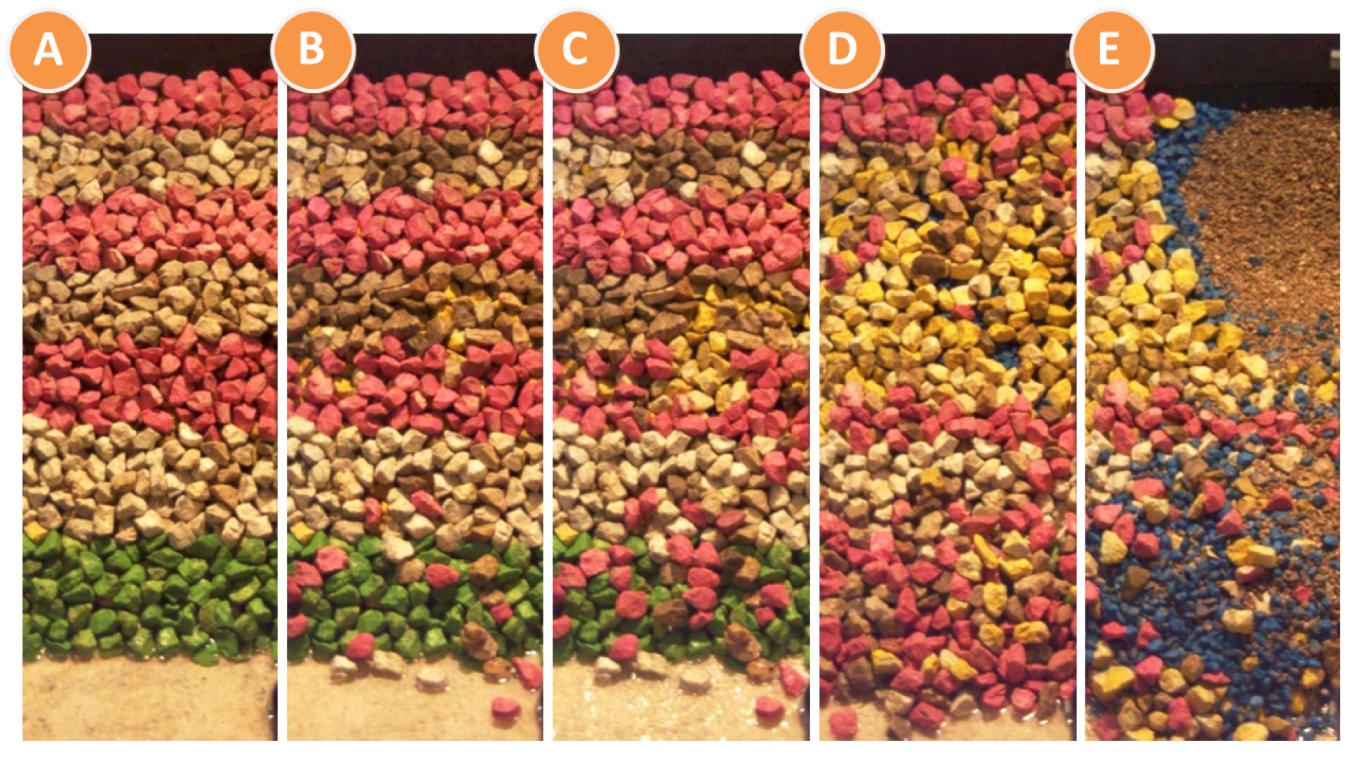
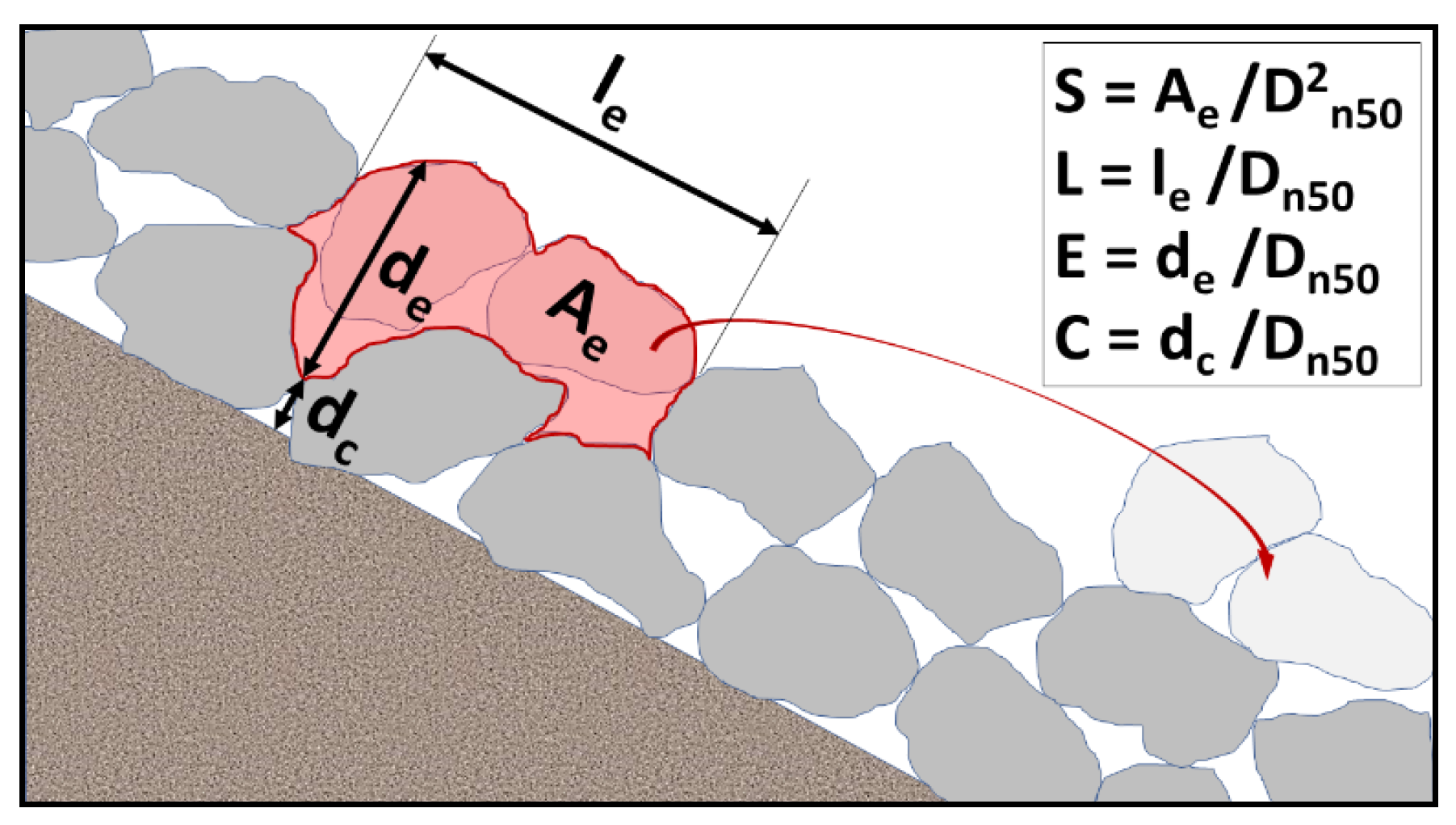
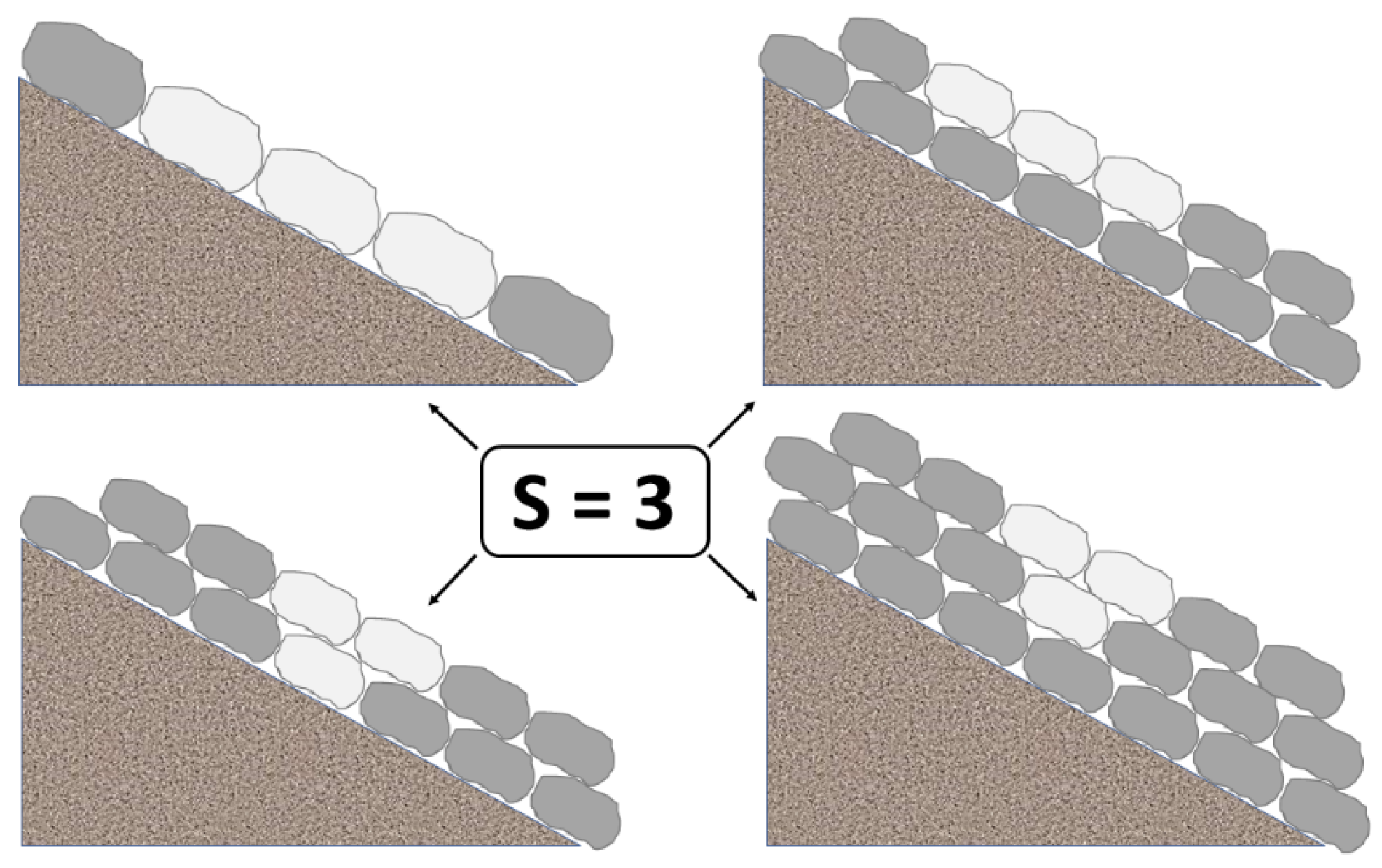
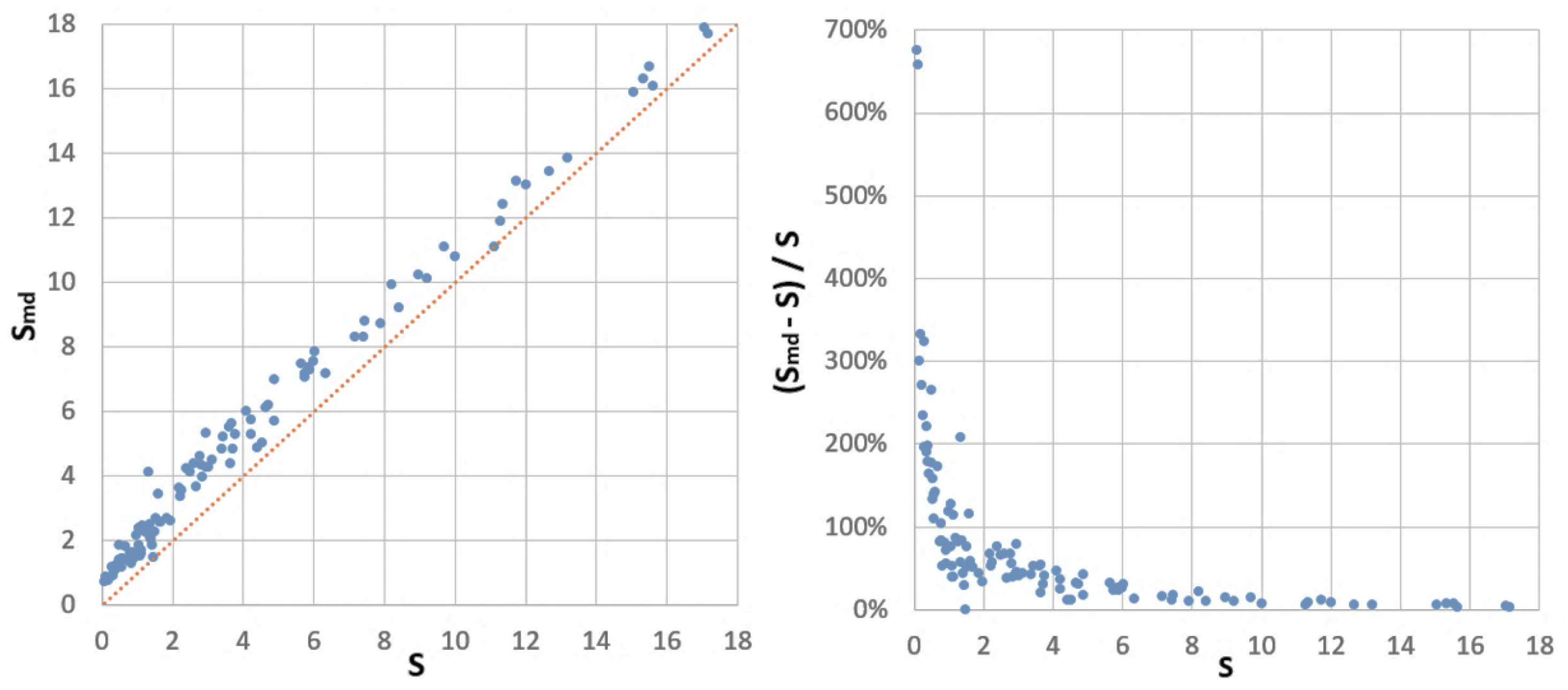
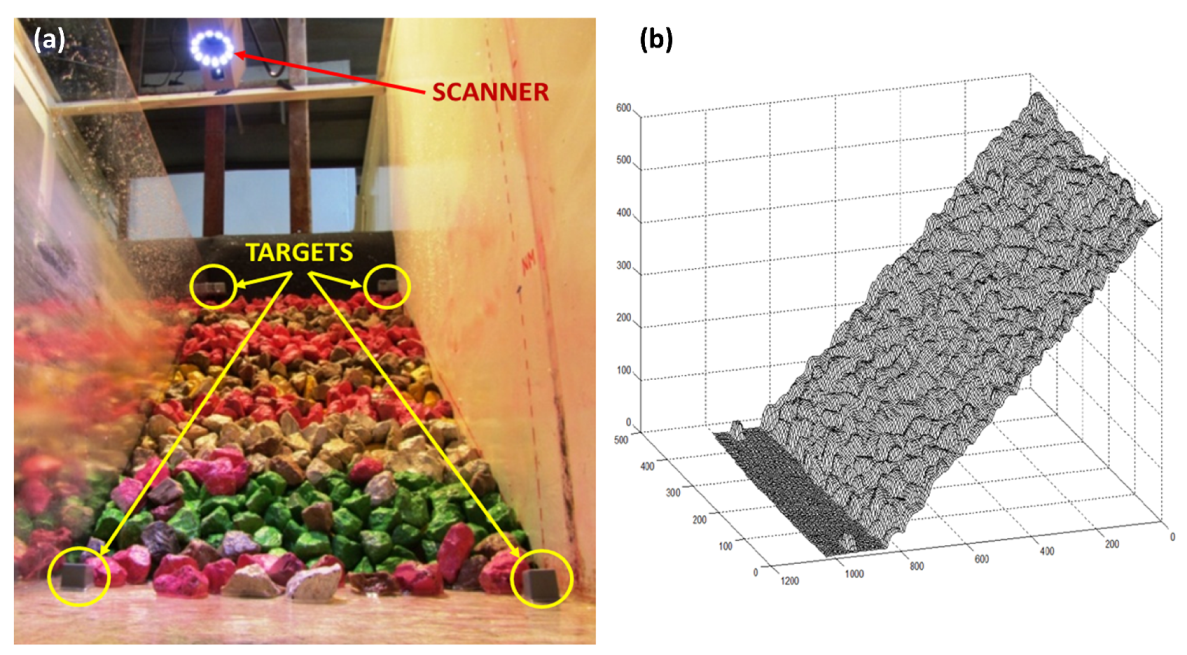

| DIMENSIONLESS EROSION AREA (S) | |||||||
|---|---|---|---|---|---|---|---|
| Threshold 1 | Threshold 2–3 | Threshold 4 | |||||
| Cot α | Damage Initiation [21] | Start of Damage [2] | Iribarren’s damage [21] | Initiation of destruction [21] | Intermediate Damage [2] | Destruction [21] | Failure [2] |
| 1.5 | 1.5 | 2 | 2.5 | 6.5 | 3 to 5 | 12 | 8 |
| 2 | 2 | 2 | 3 | 8 | 4 to 6 | 14 | 8 |
| 3 | 2.5 | 2 | 3.5 | 9.5 | 6 to 9 | 16 | 12 |
| 4 | 3 | 3 | 4 | 11 | 8 to 12 | 18 | 17 |
| Requirements of a Damage Descriptor Defined in Abanades et al. (2011) [20] | S | D% | SN | DN% | No | NΔ | St | De | C | E | L | ||
|---|---|---|---|---|---|---|---|---|---|---|---|---|---|
| Increase with damage | |||||||||||||
| Dimensionless | |||||||||||||
| Known range of variation | |||||||||||||
| Easily interpretable | |||||||||||||
| Accomplished | Partially accomplished | Not accomplished | |||||||||||
© 2020 by the authors. Licensee MDPI, Basel, Switzerland. This article is an open access article distributed under the terms and conditions of the Creative Commons Attribution (CC BY) license (http://creativecommons.org/licenses/by/4.0/).
Share and Cite
Campos, Á.; Molina-Sanchez, R.; Castillo, C. Damage in Rubble Mound Breakwaters. Part II: Review of the Definition, Parameterization, and Measurement of Damage. J. Mar. Sci. Eng. 2020, 8, 306. https://doi.org/10.3390/jmse8050306
Campos Á, Molina-Sanchez R, Castillo C. Damage in Rubble Mound Breakwaters. Part II: Review of the Definition, Parameterization, and Measurement of Damage. Journal of Marine Science and Engineering. 2020; 8(5):306. https://doi.org/10.3390/jmse8050306
Chicago/Turabian StyleCampos, Álvaro, Rafael Molina-Sanchez, and Carmen Castillo. 2020. "Damage in Rubble Mound Breakwaters. Part II: Review of the Definition, Parameterization, and Measurement of Damage" Journal of Marine Science and Engineering 8, no. 5: 306. https://doi.org/10.3390/jmse8050306
APA StyleCampos, Á., Molina-Sanchez, R., & Castillo, C. (2020). Damage in Rubble Mound Breakwaters. Part II: Review of the Definition, Parameterization, and Measurement of Damage. Journal of Marine Science and Engineering, 8(5), 306. https://doi.org/10.3390/jmse8050306






